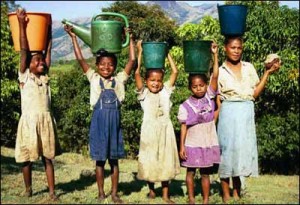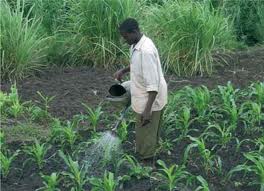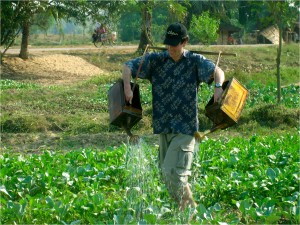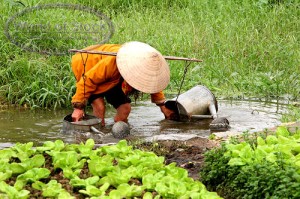Everybody in the world knows about big dams. They do irreparable damage to the  environment and the millions of people they displace, but we need to keep building a few of them to feed the nine billion people we expect will live on planet earth when its population stabilizes.
environment and the millions of people they displace, but we need to keep building a few of them to feed the nine billion people we expect will live on planet earth when its population stabilizes.

Ten years ago, ten world experts both for and against big dams formed the World Commission on Dams and reached a stunning consensus on the path forward, which the World Bank promptly decided to ignore.
But there has been no World Commission on Buckets and Sprinkling Cans, although some 50 million poor farmers in Asia and Africa use them as their primary source of irrigation.

In fact, the world’s irrigation experts turn up their noses at the very thought that the lowly sprinkling can could be considered a form of legitimate irrigation, and they studiously ignore people who irrigate with buckets and sprinkling cans even when they live and work right under their noses.
Twelve years ago, I was learning everything I could about vegetable markets in Maputo, the capital of Mozambique. Since you usually need irrigation to produce vegetables, I asked an expatriate consultant to the government of Mozambique with a PhD in irrigation and numerous scholarly papers if there was any irrigation within striking distance of Maputo.
“Not ‘til you get about 200 miles north of here,” he said.
“And the canal system there needs millions of dollars of repair work to get it to work effectively again. ”
I thanked him, stepped out of his office, and hailed a cab.
“Is there any irrigation going on around Maputo?” I asked the cab driver.
“Certainly sir. Would you like me to take you there?” he replied.
“How far is it?”
“About 15 minutes. It’s right next to the beer factory.”

Sure enough, in less than 15 minutes we pulled up to 500 lush green acres filled with vegetables, irrigated by bucket and sprinkling can. Some farmers filled their sprinkling cans from a full creek. Others took advantage of small box-like cisterns filled by gravity from the creek. On their 1/8 acre plots, they grew onions, tomatoes, and all kinds of other vegetables that they sold from small stalls in neighborhood markets.
That afternoon, I went back to the irrigation expert’s office in Maputo.
“I thought you told me there was no irrigation within striking distance of Maputo,” I said.
“That’s right,” he said.
“Well, I just visited 500 acres of irrigated vegetables 15 minutes from here,” I said, with just a tiny trace of righteous indignation.
“Where’s that?” he asked.
“Right next to the beer factory,” I said.
“Oh of course, I know about that,” he said. “But that’s not irrigation.”

“Why not?” I asked.
“Because they only use buckets and sprinkling cans” he said, and stood up, indicating our interview was coming to an end.
“That’s funny,” I said. “I thought irrigation was bringing water to plants.”
And then I knew our interview was truly over.
The trouble is that this is not an isolated case.
In a rare detailed study of primarily bucket and sprinkling can irrigation in the peri-urban area of Kumasi, Ghana in 2001, Gez Cornish and his colleagues from HR Wallingford, a well known UK water consulting firm reported that “—-In the 40 km radius around Kumasi there are estimated to be 12,700 households irrigating at least 11,900 ha..” (For More visit Article – Informal irrigation in the peri- urban zone of Kumasi, Ghana )
In the year before, using numbers prepared by the Food and Agriculture Organization (FAO) the government of Ghana reported that the total irrigated acreage in Ghana was a mere 6,400 ha, a little less than half the acreage irrigated by bucket and sprinkling can alone in the outskirts of just one city in Ghana.
To the experts at FAO and the government of Ghana, irrigation by sprinkling can simply doesn’t exist, so there’s no use learning about it, measuring it, and figuring out how to improve it.

How many more hectares are there in Ghana that are irrigated by sprinkling can and bucket?
Nobody knows and nobody cares.
How many more smallholders earn their primary livelihoods growing vegetables irrigated by sprinkling cans and selling them in nearby towns and cities in Ghana, and in all of Sub Saharan Africa?
Nobody knows and nobody cares.
But if the ratio of 12,700 sprinkling can farmers to 900,000 population of Kumasi holds up for the nine million or so people who live in urban areas in Ghana now, there would be about 120,000 bucket farmers in Ghana today, irrigating about 110,000 ha. This would represent 11 times the 10,000 Ha of formal irrigated acreage reported by the Government of Ghana now.

When I extrapolate this rough calculation to the 270 million or so people who live in urban areas in Sub Saharan Africa now, I come up with a very rough estimate of 36 million farmers who use sprinkling cans and buckets as a primary form of irrigation in Sub Saharan Africa. It could be 50% higher or lower, but it will do for a start. One thing is very clear- there is a very large number of them!
The world is so caught up in debates about big dams and big canal systems that it routinely misses the obvious.
I would take only a tiny fraction of the billions we spend now on big projects that don’t work to do three obvious things to learn about sprinkling can farmers and help them double or triple their productivity and income.
How Sprinkling Can Farmers can improve their Livelihood?
1. Carry out a serious survey of sprinkling can farmers around the world to learn everything there is to learn about what they do now and how they do it.
2. Carry out pilot projects in two or three countries to double the income and productivity of Sprinkling Can Farmers by taking advantage of affordable labor saving irrigation tools, like treadle pumps and low cost drip systems, improved farming practices and better access to markets.
3. Rapidly scale up multi-country initiatives to double the income of tens of millions

In next week’s blog, I will talk about what I’ve learned from interviewing bucket farmers about promising ways their harvest and incomes could be dramatically improved.

Great job Paul!
Chapin Living Waters is a small Christian organization that has “Bucket Kits” that do the same. Check us out at http://www.chapinlivingwaters.org
Blessings.
Richard
Paul I loved this article because it shows both our existing problems and ways to build on the successes we see now. It’s not enough to have good intentions we need to be people centered in our approaches to design problem solving.
Thanks for bringing another small-scale solution to light. Too often we assume that only big solutions matter.
Pingback: Paul Polak’s New Blog | Appropedia Blog